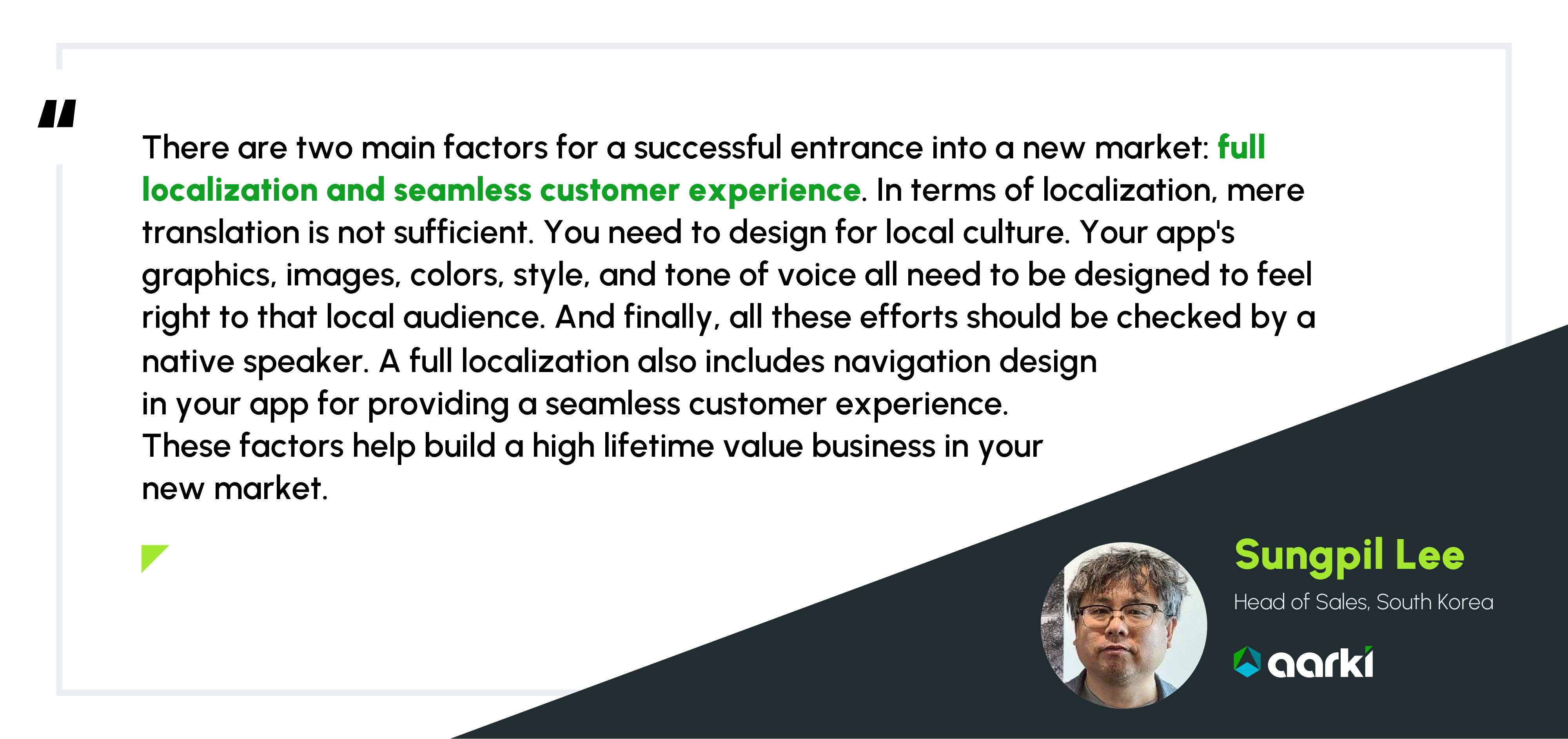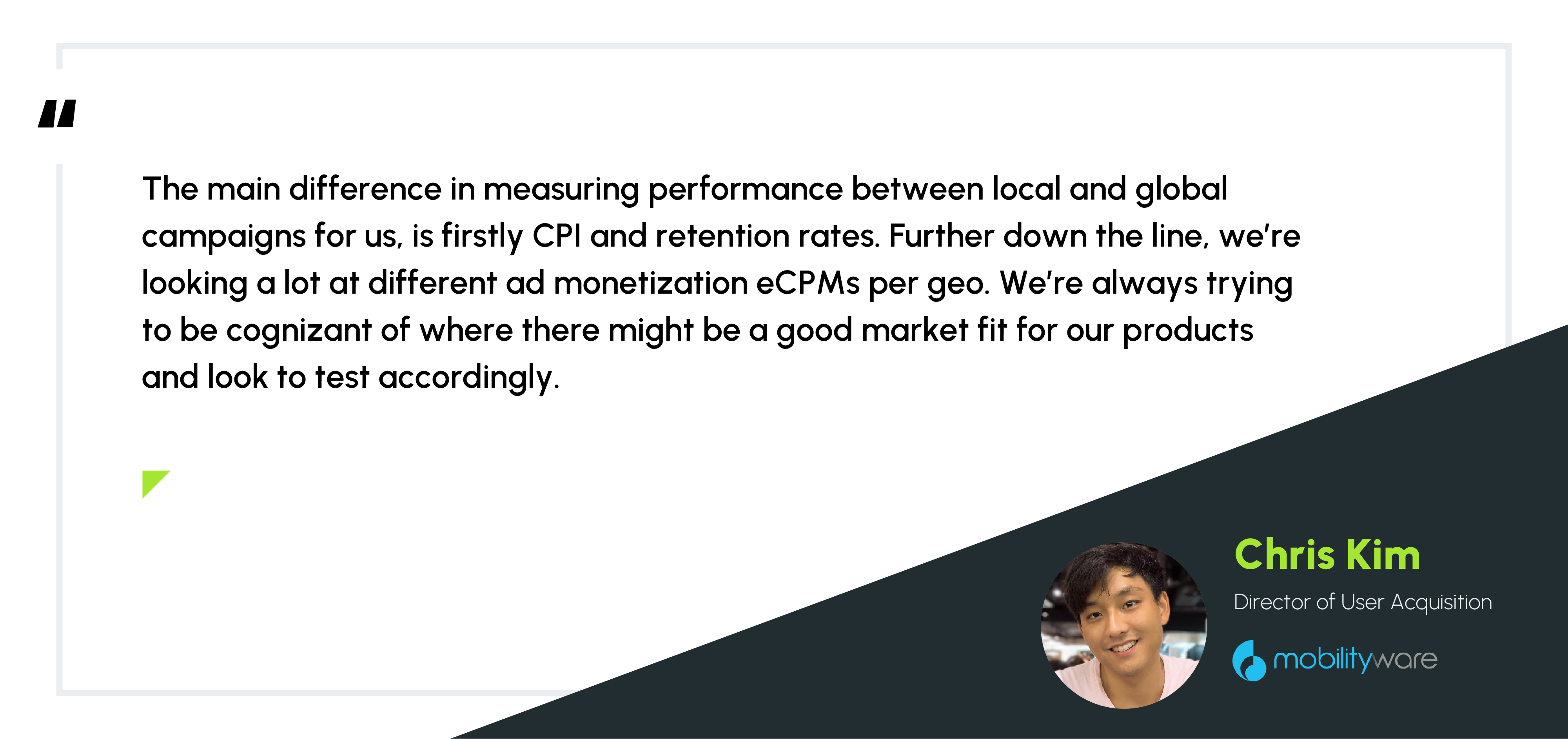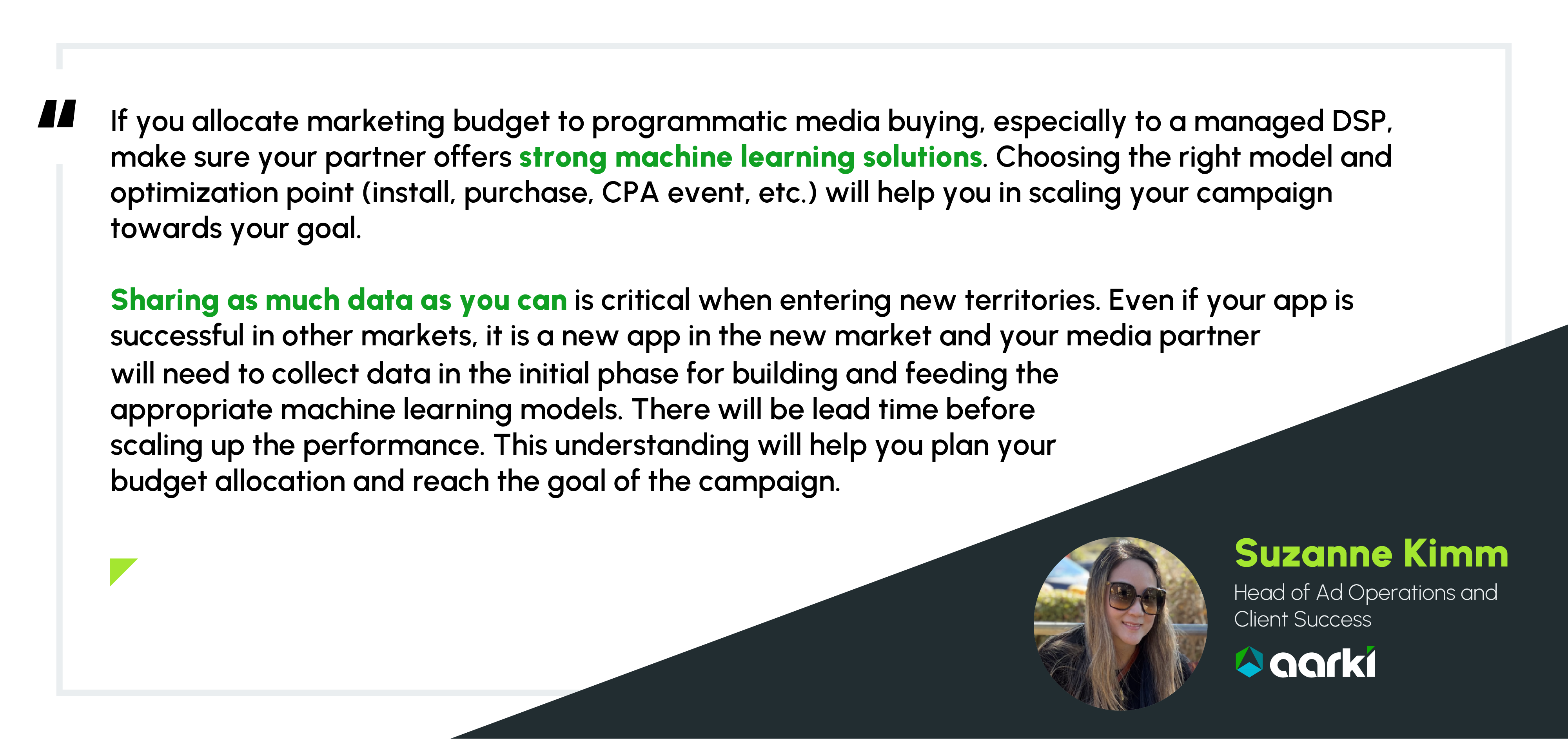
The biggest opportunity to grow your app’s user base may lie outside your home country, so establishing an international presence for your mobile app can help you maximize your app’s chances of success. With so many examples of successful app globalization, isn’t it time you gave it a try?
Quick Links
- The Importance of Going Global
- Setting Goals and KPIs
- Planning Budgets
- Machine Learning Models and Data
- Creative Strategies
- Creative Checklist
- Reporting
The Importance of Going Global
Before diving in, it’s crucial to understand the importance of going global.
The ever-changing global landscape highlights the need to prioritize globalization of mobile apps in marketing campaigns. With the constant threat of change in government policy and industry regulations – changes that could drastically affect campaigns in an instant – it’s essential to have a comprehensive global strategy in place. One that takes into account local guidelines, as well as cultural differences. Economic changes can greatly impact user buying behavior, so it is vital that campaigns are tailored by market. Prioritizing the globalization of mobile apps will ensure your campaigns resonate with each target audience, driving engagement and conversions, and ultimately, success.
Expanding your mobile app’s presence globally will not only maximize your chances of success, it will also serve as a safety net for your revenue. Aggregating your market share across multiple countries can reduce your dependency on one market and ensure business sustainability in the long run.
For the transition from local to global to run smoothly, you need a strategy. In this article we dive into the key points you need to consider before you get started.
Setting Goals and KPIs
The success of your app marketing strategy should be tied to key performance indicators (KPIs). Effective scaling requires a clear set of goals per region. Before you dive into the world of globalization, figure out what your overall objectives are. Mobile app developers generally want three things: more downloads, more revenue, and continued user engagement. To achieve these goals, you will need to measure the following KPIs:
- Cost per Install (CPI)
- Cost per Reactivation (CPR)
- Cost per Mille (CPM)
- Click-Through Rate (CTR)
- Conversion Rate (CR)
- Retention Rate (RR)
- Churn
- Lifetime Value (LTV)
- Return on Investment (ROI)
The benchmark for these KPIs will be different in each region, so it’s important to configure your analytics, do research, and set the right expectations by market.

Planning Budgets
Once you have defined your KPIs, the next step is to plan your budget. It is a good idea to start small with a low budget, giving your media partner time to see what works. Once this phase is complete you can increase your spend. Prudent financial decisions are important when you are dealing with a small amount of capital. Let your media partner guide you in the timing of your test campaigns and be sure to set up your reporting to closely monitor your campaign’s ability to deliver results.
One of our clients who is experienced in the management of multiple gaming apps in multiple countries, suggested that setting realistic goals for your campaigns is critical. The first step is to estimate the CPI’s you can expect in the market you are about to launch in. Then, based on data and CPI benchmarks obtained from your partner, decide whether the market is suitable for a test, if the CPI’s are optimal, and whether you can expect to be profitable in that market. If you go live in the market, start with a low budget, one that is enough to support the time it takes to learn about the market. If the outcome is positive – that is, if the ROI prediction model is positive – you can increase the budget gradually whilst keeping an eye on the CPI’s and ROI.
Another client mentioned that they consider the region where their core users are located as a starting point. On the budget allocation side, they generally dedicate about 80% of the marketing budget to the core market, while the remaining budget is allocated to testing other geographic locations in search of possible opportunities. As for the KPI setup, they focus on in-app purchases, with Day 7 ROI performance being the key metric to measure the channels’ perspective. Of course, market surveys are also an essential part of their path towards globalization as they serve as a stepping stone for data-driven localization.
Machine Learning Models and Data
When it comes to globalization, selecting the right media partners is crucial. To ensure scalability of campaigns, it’s important to partner with a demand-side platform (DSP) that has global reach. Look for DSP’s that own global data centers and have strategic partnerships with both large and local exchanges, as this ensures coverage of different ad formats across various markets.
But it’s not just about coverage. Another factor that differentiates a great media partner is their focus on building predictive models and their ability to identify which data is valuable for training machine learning models. Look for a partner that offers custom machine learning algorithms trained on down-funnel KPI’s that optimize for events such as registration, sale, and purchase. The abundance of tools that makes it easy for you to share your data is another factor to consider.
Moreover, it’s essential to have a media partner that evolves alongside the industry. Digital advertising is a constantly changing landscape, and staying ahead of the curve is crucial to success. This is where a partner that innovates on creative capabilities and ML models to fit the needs and requirements of advertisers and the ecosystem can be incredibly valuable. By utilizing the latest technologies and staying up to date with industry trends, a media partner can help you achieve your marketing objectives while also ensuring maximum ROI.

Creative Strategies
Your ad creative is the representation of your brand and the backbone of your mobile advertising campaign. A carefully planned creative strategy may be your trump card in your journey to globalization.
Use your data to inform your ads and run creatives targeted to a specific audience. Localize your ad creatives to adapt to different markets. Past performance of Aarki’s numerous global campaigns has shown that the most localized ads perform better than standard non-translated ads.

To help you tap into new territories, we have created a checklist that is sure to boost your creative ads.
Creative Checklist
1. Mind the culture, not mere translations
Know the region you are entering and be authentic to it in your ad creative. Being mindful of the market – considering their preferences and specifications – is a good step towards resonating with global audiences. Our creative specialist in Korea helped us understand some of the design trends we see in his local market, as well as in APAC.
Senior Creative Specialist in Korea, JunHyung Hong, believes that South Koreans like to keep it local – preferring apps in their own language. Most users opt for large-screen devices, which helps explain why video is more popular here than in other regions. This is a great opportunity for marketers, as video creatives are far better at showcasing an app and highlighting its features.
A focus on the typography, color and design elements are essential in Korea. JunHyung says that it totally depends on the concept of the app, but simple design and typography is best for attracting the audience.
In Korea, users are influenced by the creative elements of the mobile ad, whereas Western audiences are more focused on the call to action and the product advertised. Korean mobile ads are influenced by the design elements — fonts, colors, transitions, and effects— which impact the engagement of the audience. These design elements prove the value of the mobile app and whether it can be trusted. Visually appealing and minimalistic ads are more favoured here than elaborately animated ads or out of the box concepts.
As for the trends, Korean design is based on simplicity, expressed in typography, composition, and the color pattern.
2. Separate texts from images
Embedding text into images might be convenient in production, but it causes delays and leads to added cost when trying to localize your app. So make sure you separate the text from images wherever possible. It will make it easy to translate your copy.
3. Mind the space
In today’s hyper-connected world, we exchange more words than ever. So, it is vital to find a way to make your words stand out. This refers both to your app content as well as to your advertising copy.
Different languages require different amounts of space in the design. This is because it takes more (or less) words in specific languages to communicate the same content. For example, translating from English into languages such as Spanish or French can result in a 20-25% expansion. Translating into German may result in an even greater expansion – as much as 35%. The Chinese, Korean, and Japanese language results in the opposite and will usually contract. Something to consider when translating text is that you may need more space for some translations, and you may end up with blank spaces in others. To avoid this, make sure that the design of your app considers all future possibilities of different languages, and different types of texts – for example the right-to-left layout of Arabic and Hebrew, and the vertical layout of Japanese.
4. Avoid hard coding texts, especially currency, time, and date formats
Localization is not a straight translation, so if you are planning to localize your app in the future, you should avoid hard coding functions like currency, time, and dates from the start. The world is wildly inconsistent regarding time and date formats. Some countries put the month first, and others put the day first. Some use a 24-hour format, while some use 12-hour splits. Some use AM and PM, and others do not. Currency varies too. Have you noticed how many types of dollars exist? We counted more than 20!
Now that you have the creative checklist for globalizing your mobile app, lets discuss the advertising strategies you can use to promote your app globally.
5. Leverage one or more of the below strategies
- Design promo-based ad creatives.
- Show sales promotions, deals, and offers.
- Promote the benefits/rewards of your app.
- Use gift vouchers, coins, or exclusive deals to first-time users or loyal app users.
- Highlight testimonials from satisfied buyers that affirm the value of your product or service.
- Exploit the benefit of instructional/tutorial creative ads.
- Show how easy it is to use your product or service.
- Demonstrate the app features.
- Highlight unique and best-selling features.
Creative optimization should be the focal point of your campaign planning, irrespective of the region you are entering. Your A/B testing should not only focus on broad differences. Sometimes changing small details like background elements, the color of the call to action (CTA), or a word in the copy can be enough to grab the attention of your app users. Moreover, you can test multiple variants of ad elements to determine the most effective combination for a single ad.
Reporting
Transparency in reporting gives the advertisers and the media partner the ability to drill down into performance data and optimize on a granular level. When entering new markets, work with a partner who has the right reporting tools to make sure that optimizations are guided by valuable performance data.
For Android app advertisers and iOS app advertisers whose users share IDFA, the reporting should be at the impression level. Ad placements, the audiences reached, and the return on ad spend should all be visible to the advertiser. The campaign data and the app events that are attributed to the campaign should be easily viewed on reporting dashboards and passed via API’s to reporting tools that enable the advertiser to have end-to-end performance visibility.
There are several limitations in reporting after the release of iOS 14.5 and the launch of the App Tracking Transparency (ATT) framework for users who opt-out of IDFA, however, this can be mitigated by working with a media partner who will ensure transparent reporting by integrating with all major MMPs.
Feeling more informed about your next steps towards globalization? Give it a try and let us know your feedback. Contact us with questions.